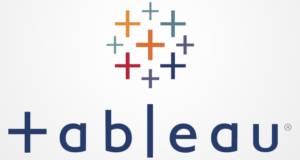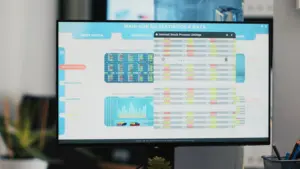A dashboard is a collection of many views that lets you compare a variety of data simultaneously. For example, if you contain a set of views that you review every day, then instead of navigating to separate worksheets, you can create a dashboard that displays all the views at once. After you have created one or more sheets, you can combine them in a dashboard, add interactivity, etc.
How to create a dashboard and add or replace sheets:
A dashboard can be created in the same way you create a new worksheet.
- Click the New Dashboard icon available at the bottom of the workbook.
- From the list of Sheets available at left, drag views to your dashboard at right.
For replacing a sheet, select the sheet (at right side) you want to replace in the dashboard and hover over the replacement sheet from the list of Sheets available at left, and click the Swap Sheets button.
Add dashboard objects and set their options:
You can also add dashboard objects that add visual appeal and interactivity. The different types of objects available are given below:
- Horizontal and Vertical objects give layout containers that let you group related objects together and adjust how your dashboard should resize when users interact with them.
- Text objects give headers, explanations, and other information.
- Image objects add the visual flavor to a dashboard, and you can link them to specific target URLs.
- Web Page objects show target pages in the context of your dashboard. Be sure to review the web security options, and be aware that some web pages do not allow themselves to be embedded.
- Blank objects help you adjust the spacing between dashboard items.
- Navigation objects let your audience navigate from one dashboard to another, or other sheets or stories. You can also display text or an image to indicate the button’s destination to your users, specify custom border and background colors, and provide informational tooltips.
- Download objects let your audience quickly create a PDF file, PowerPoint slide, or PNG image of an entire dashboard, or a crosstab of selected sheets.
- Extension objects allow adding unique features to dashboards or integrate them with applications outside Tableau.
How to add an object:
From the Objects section present at the left side, drag an item to the dashboard on the right:
How to set options for objects:
Select the object container and click the arrow in the upper corner to open the shortcut menu.
Set overall dashboard size:
Under section Size on the Dashboard pane, select the dashboard’s dimensions (such as Desktop Browser) or sizing behavior (for example, Automatic) to set the size of the dashboard.
Group items using layout containers:
Layout containers let you group related Tableau dashboards items so you can quickly position them. Other container items automatically adjust as soon as you change the size and placement of items inside a container.
Layouts are of two types:
- A horizontal layout container resizes the width of the views and objects it contains.
- A vertical layout container adjusts the height.
How to add a layout container:
Under the section Objects on the Tableau Dashboards pane, select either Horizontal or Vertical and drag the container to the dashboard.
Create Dashboard Layouts for Different Device Types:
Tableau Dashboards include layouts for different types of devices that offer a wide range of screen sizes. When you publish any of these layouts to Tableau Server or Tableau Online, people experience a design optimized according to their phone, tablet, or desktop.
Automatically add phone layouts:
There are two options to add phone layouts automatically:
- To create phone layouts while opening old dashboards, choose Dashboard > Add Phone Layouts to Existing Dashboards.
- To create phone layouts while creating a new dashboard, choose Dashboard > Add Phone Layouts to New Dashboards. This option is by default.
Manually add device layouts:
Open the dashboard and on the Dashboard tab on the left, click on Device Preview.
- In device preview mode, these options are available:
- Click all Device types and Models and explore the different types of screen sizes and set these options:
- To know how the Tableau dashboards will look in landscape mode vs. portrait mode, click. Usually, the landscape is best for tablets, and the portrait is best for phones.
- Select the Tableau Mobile app to know how the dashboard will look with the app instead of the browser. This option is only available for iOS or Android devices and shrinks the dashboard slightly, leaving space for the available app controls.
- Choose a Device type, like Tablet.
- Click the Add Layout button in the upper-right corner for the device type you have selected.
- You can also add an additional layout by selecting a new Device type and clicking Add Layout.
How to customize a device layout:
After adding a device layout to your dashboard, you can rearrange objects to create the look you want.
For Desktop and Tablet layouts, click on the tab Custom:
For the Phone layouts, either click the lock icon or choose Edit Layout from the pop-up menu:
Anything you have added to your layout is visible on the left, under the layout. If an item contains a blue checkmark, it means that it is a part of the device layout on which you are currently working.
If you have removed an item, it is only removed from the current device layout but still exists on the default dashboard and added to the device layout again.
Click through the different Device model options available to see how the layout will appear on different models.
At the left side, explore the options available under Size:
- Default: The width and height of the device layout copy whatever the default dashboard is using. For example, if you create a tablet layout and the default dashboard is set to a fixed size of Desktop Browser (1000 x 800), setting the Size to Default for the tablet layout will make it use 1000 x 800 as well.
- Fit all: All items will automatically be resized to fit the device frame size. The device frame size is determined by the Device type, Model, and orientation (portrait or landscape) settings.
- Fit width (recommended for phones): Items will automatically be resized to fit the width of the device frame, but the height is fixed. This is the best option for phone layouts and vertical scrolling.
Hide or unhide all sheets:
To hide all dashboard or story sheets, right-click (Windows) or Control-click (macOS) on the dashboard tab available at the screen bottom, and select Hide All Sheets. You can later choose Unhide All Sheets whenever needed.
Hide an individual sheet:
Look for the sheet you want to hide in the tabs at the bottom of the screen. On the other hand, if you are viewing a dashboard or story, look in the Sheets list at left:
Right-click (Windows) or Control-click (macOS) the sheet name, and select Hide Sheet.
Unhide an individual sheet:
To unhide a sheet, click the tab for the dashboard or story that contains the sheet available at the bottom of the screen. You can also identify dashboards and stories by grid and book icons, respectively.
In the list available at left, right-click (Windows) or Control-click (macOS) the sheet and clear the Hide Sheet checkbox.






























3 Responses